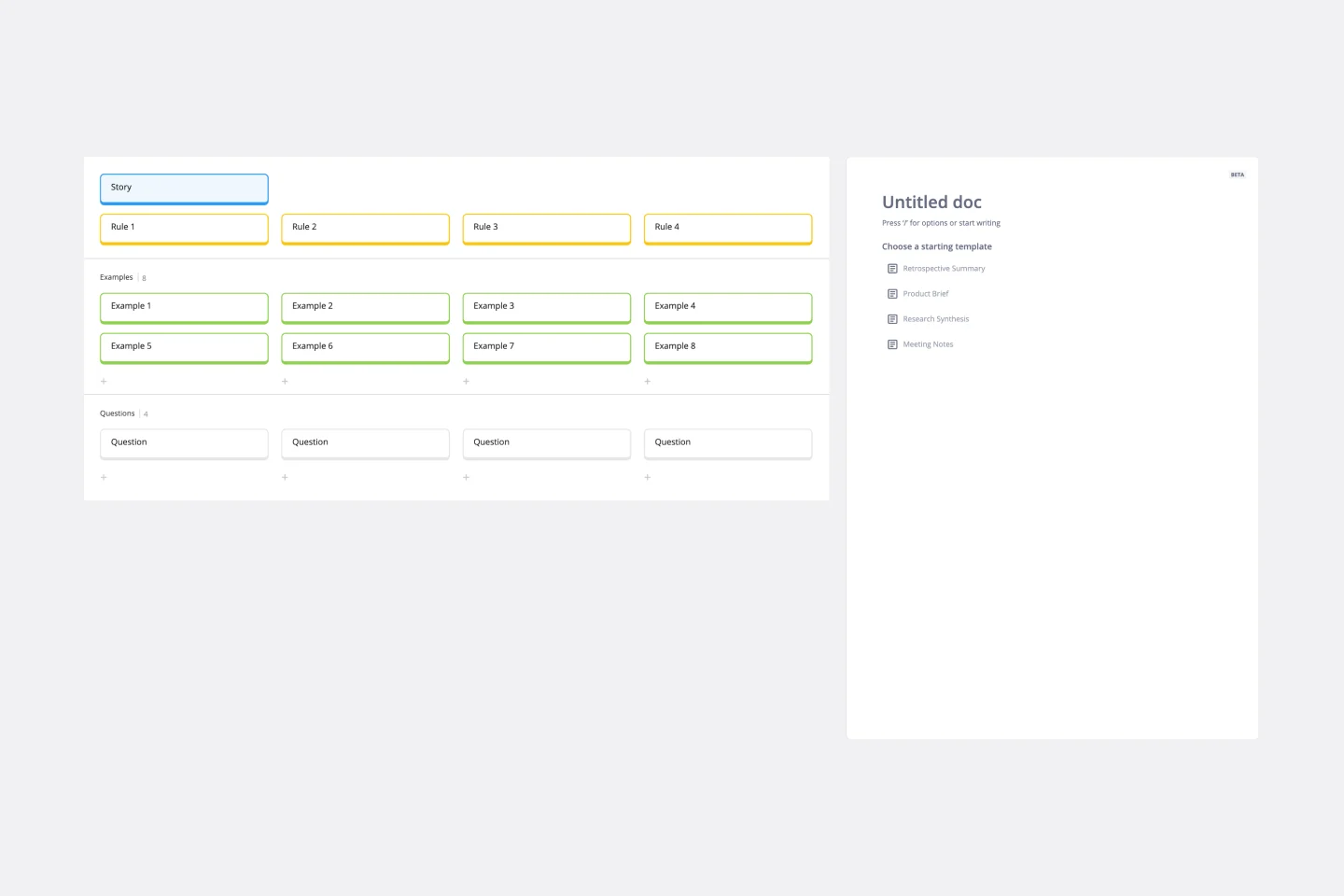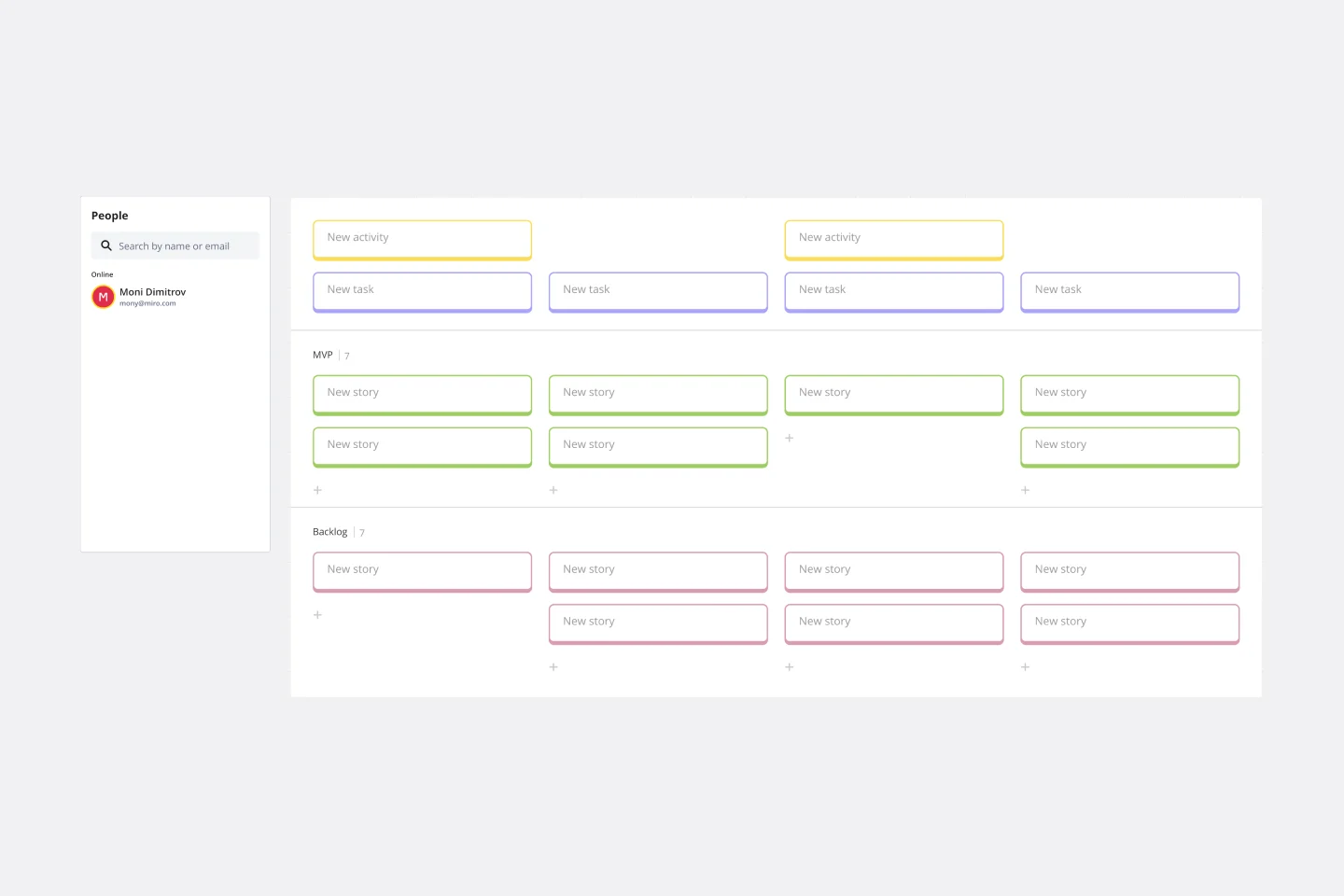About the Jobs To Be Done Framework
Jobs To Be Done (JTBD) is a theory of customer demand that describes why and how people decide to adopt new products or services. JTBD theory states that people shop and buy new products to transform their current situation and make progress on their goals. This is their Job to be done.
Product managers, marketers, and entrepreneurs use this theory to lower the risk of going to market with solutions people won’t buy.
Keep reading to know more about the Jobs to be Done framework template.
When to use the Jobs To Be Done Template
The Jobs To Be Done template makes it easy to put JTBD theory into practice and helps you analyze both the demand creation and hiring processes.
You can use the Jobs To Be Done framework template to directly capture all the necessary data points after conducting customer interviews. Alternatively, you can use it to summarize the series of customer interviews and the conclusions about the Jobs that customers are trying to get done.
By using the Jobs to be Done framework template, you will know why people choose your product or service, and you will be able to better attend to your demand and have more success in terms of sales and expansion.
A Jobs to Be Done example explained
One practical example of the Jobs to Be Done framework is when a Team Lead wants to enable their team to work more creatively and collaboratively. Their Job is not done yet, because there are some constraints.
The Team Lead noticed that people have worked in silos in the past and don’t want to change their ways of working. This interplay between goals and opposing constraints motivates the Team Lead to go and look for new solutions. Goals and constraints together create demand for new solutions. These events or realizations are called catalysts. They create urgency and often trigger the need for new products.
When people look for new solutions to accomplish their goals, they look for everything that helps them achieve their progress. In our example, it could be a tool, a training, a consultant, and so on. This is called a choice set, and it can be very diverse, going beyond a particular product category.
The process customers go through as they look for new solutions on the market is called hiring. People hire products to get their jobs done, similarly to a manager hiring new employees.
During the hiring process, people compare their current solutions to their considered options. Eventually, they hire a new solution and fire the old one**.** What makes the solution a winning one is when it seems trustworthy,and novel and gets customers to imagine how the solution works. This is what ultimately shapes their willingness to pay.
As customers decide and hire a solution, they continuously look for progress signals that show them if their solution had the desired effect.
How to capture research insights with the Jobs To Be Done template
Start by conducting interviews with recent buyers of your product or service. Talk to people who recently switched to your product, have used it for at least 2 or 3 months, and were in charge of making the final buying decision.
Separate your findings into three stages:
Demand creation
Get together to synthesize the unmet needs of your ideal customers. Start by first listing their goals and then constraints that block them from reaching those goals.
List all the events, frustrations, experiences, and other catalysts that created urgency during their shopping process.
Desired progress
Form groups and summarize your insights in a short story about your ideal customer and why they decided to make a change. Compare the stories of each group and discuss their nuances. Use the story later to inspire new ideas and align your team.
From your story, distill a simple Job to Be Done statement that expresses the key benefits customers are looking for.
Capture how the customer knows they are making progressas progress signals.
Hiring
List which solutions, products, or behaviors they hired, fired,andconsidered for their Job To Be Done.
Discuss each aspect of the hiring process. Use green and red stickies to highlight elements that increased or decreased trust, made the product seem good or bad value for money, and that helped or didn’t help customers imaginehow the product could be used. Lastly, list factors that made the product seem novel or familiar.
After summarizing one or all of your interviews in this way, use the data to inspire changes to marketing, product, or sales. Jobs to be Done data enables you to reveal your ideal customer and design products that appeal to them.
FAQ about Jobs to be Done Framework
What is the Jobs To Be Done framework?
The Jobs to be Done framework is a way to develop products considering your customer goals or their ‘jobs’. It’s also an approach to how your customer will ‘hire’ your product or service. With the Jobs to be Done framework, you will know why people choose your product or service, and you will be able to better attend to your demand and have more success in terms of sales and expansion.
Why is Jobs To Be Done important?
Using the Jobs to Be Done Framework is important because it helps you better understand why and how people decide to adopt new products or services. Product managers, marketers, and entrepreneurs use JTBD theory to lower the risk of going to market with solutions people won’t buy. Ensure you and your team make the right decisions by using Miro’s Jobs To Be Done Template!

Miro
Your virtual workspace for innovation
Miro is an innovation workspace designed for teams of every size, everywhere, to dream, design, and build the future together. Our mission? To empower these teams to create the next big thing, powered by AI at every step of the way. Over 90 million users around the world rely on Miro to untangle complex ideas, put customer needs first, and deliver products and services faster. All supported by best-in-class security, compliance, and scalability.
Categories
Similar templates
Example Mapping Template

Example Mapping Template
To update your product in valuable ways—to recognize problem areas, add features, and make needed improvements—you have to walk in your users’ shoes. Example mapping (or user story mapping) can give you that perspective by helping cross-functional teams identify how users behave in different situations. These user stories are ideal for helping organizations form a development plan for Sprint planning or define the minimum amount of features needed to be valuable to customers.
Job Map Template

Job Map Template
Want to truly understand your consumers’ mindset? Take a look at things from their perspective — by identifying the “jobs” they need to accomplish and exploring what would make them “hire” or “fire” a product or service like yours. Ideal for UX researchers, job mapping is a staged process that gives you that POV by breaking the “jobs” down step by step, so you can ultimately offer something unique, useful, and different from your competitors. This template makes it easy to create a detailed, comprehensive job map.
User Story Map Template

User Story Map Template
Popularized by Jeff Patton in 2005, the user story mapping technique is an agile way to manage product backlogs. Whether you’re working alone or with a product team, you can leverage user story mapping to plan product releases. User story maps help teams stay focused on the business value and release features that customers care about. The framework helps to get a shared understanding for the cross-functional team of what needs to be done to satisfy customers' needs.
Example Mapping Template

Example Mapping Template
To update your product in valuable ways—to recognize problem areas, add features, and make needed improvements—you have to walk in your users’ shoes. Example mapping (or user story mapping) can give you that perspective by helping cross-functional teams identify how users behave in different situations. These user stories are ideal for helping organizations form a development plan for Sprint planning or define the minimum amount of features needed to be valuable to customers.
Job Map Template

Job Map Template
Want to truly understand your consumers’ mindset? Take a look at things from their perspective — by identifying the “jobs” they need to accomplish and exploring what would make them “hire” or “fire” a product or service like yours. Ideal for UX researchers, job mapping is a staged process that gives you that POV by breaking the “jobs” down step by step, so you can ultimately offer something unique, useful, and different from your competitors. This template makes it easy to create a detailed, comprehensive job map.
User Story Map Template

User Story Map Template
Popularized by Jeff Patton in 2005, the user story mapping technique is an agile way to manage product backlogs. Whether you’re working alone or with a product team, you can leverage user story mapping to plan product releases. User story maps help teams stay focused on the business value and release features that customers care about. The framework helps to get a shared understanding for the cross-functional team of what needs to be done to satisfy customers' needs.